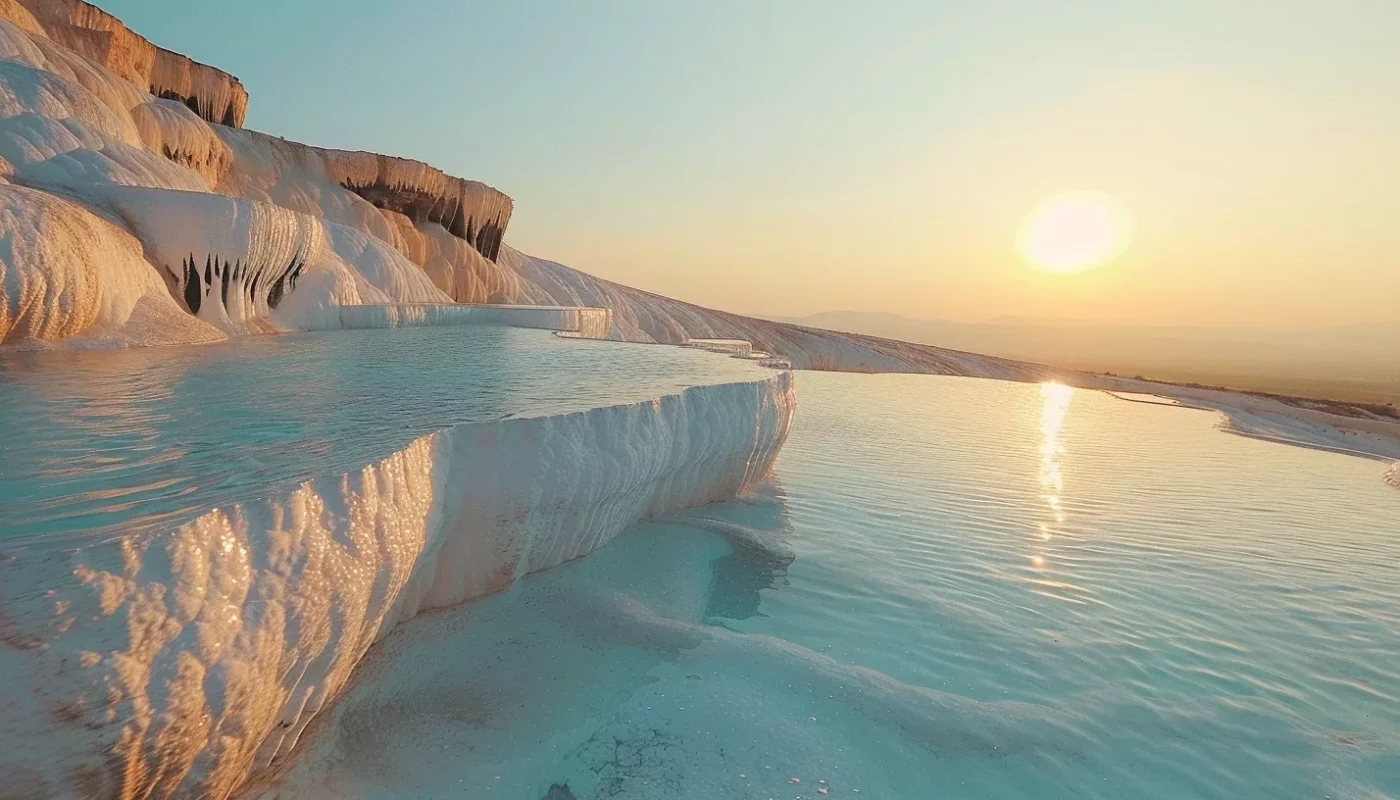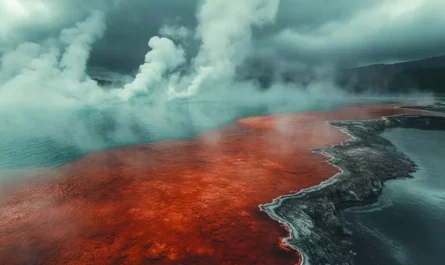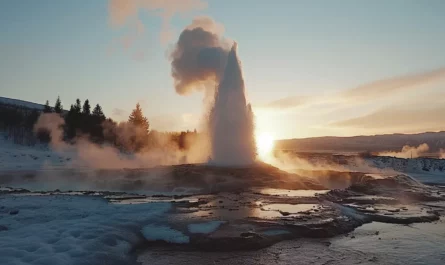Pamukkale, meaning “cotton castle” in Turkish, is a natural site in Denizli Province, Turkey. It boasts the famous Pamukkale Thermal Pools. These pools are warm, mineral-rich, and form the breathtaking travertine terraces. Pamukkale sits in Turkey’s Inner Aegean region and has been a magnet for visitors since ancient times.
The terraces are made of travertine, a sedimentary rock. This rock comes from mineral water from the hot springs. The unique landscape wows all who see it.
In 1988, Pamukkale joined the list of UNESCO World Heritage Sites. It offers an experience unlike any other. Its thermal pools provide relaxation and rejuvenation. Meanwhile, the travertine terraces offer a stunning view that impresses everyone. The area’s travertine formations built up over thousands of years by flowing, mineral-rich waters. These formations make the terraces stand out as a natural marvel.
Pamukkale is celebrated for its striking beauty. Yet, there’s a major push for conservation to protect its delicate ecosystem. These efforts make sure future generations can also admire this incredible place. Pamukkale’s thermal pools are perfect for those seeking rest, natural beauty, and a link to Turkey’s rich geological and cultural heritage.
Exploring Pamukkale’s Natural Beauty.
Pamukkale is a stunning place in Turkey, known for its natural beauty. It is famous for its huge natural terraces made by mineral-rich water. These terraces are about 2,700 meters long, 600 meters wide, and 160 meters high.
The hot springs in Pamukkale are between 35 to 100 degrees Celsius. These springs help form the beautiful terraces. People have used these waters for healing since old times.
Visitors can enjoy the warm waters and the amazing view of the terraces. It’s an enchanting experience. The peaceful waters and lovely scenery bring a feeling of calm and amazement.
Pamukkale wows visitors with its mineral waters and natural terraces. It’s a place where nature’s beauty and healing come together. This stunning spot is a feast for the senses.
The History of Hierapolis.
The ancient Greek city of Hierapolis was built over the travertine terraces of Pamukkale. This place was a Roman city famous for its healing springs. Founded in the 2nd century BC, Hierapolis was known for its healing hot springs.
The city was hit by a huge earthquake in 17 AD which destroyed it. But Hierapolis rebuilt itself and thrived again. Now, people can see the ruins of Hierapolis and how well it has been preserved.
The amphitheater in Hierapolis is a big attraction, being one of the world’s oldest. It was a place for shows and cultural events for the city’s people and visitors.
Explore the rich history of Hierapolis as you walk among its ancient ruins. Be amazed by the architectural wonders that have lasted through the ages.
Conservation Efforts at Pamukkale.
In recent years, the focus on preserving Pamukkale’s natural beauty has increased. There’s a big effort to protect this unique UNESCO World Heritage Site. These efforts aim to save its fragile travertine formations and thermal pools.
The terraces faced damage from neglect and development before. Hotels were torn down and access to the pools was limited to save them. These steps are key to keeping the travertine formations safe for future generations.
Controlling the water from the springs is another big conservation move. This helps keep the pools’ white look, which makes the site so special. Also, they made artificial pools for tourists. This helps protect the natural ones from too much human impact.
These actions are crucial for Pamukkale’s environment. They find a balance between letting people visit and protecting the site. This ensures we can enjoy these thermal pools without harming their future.
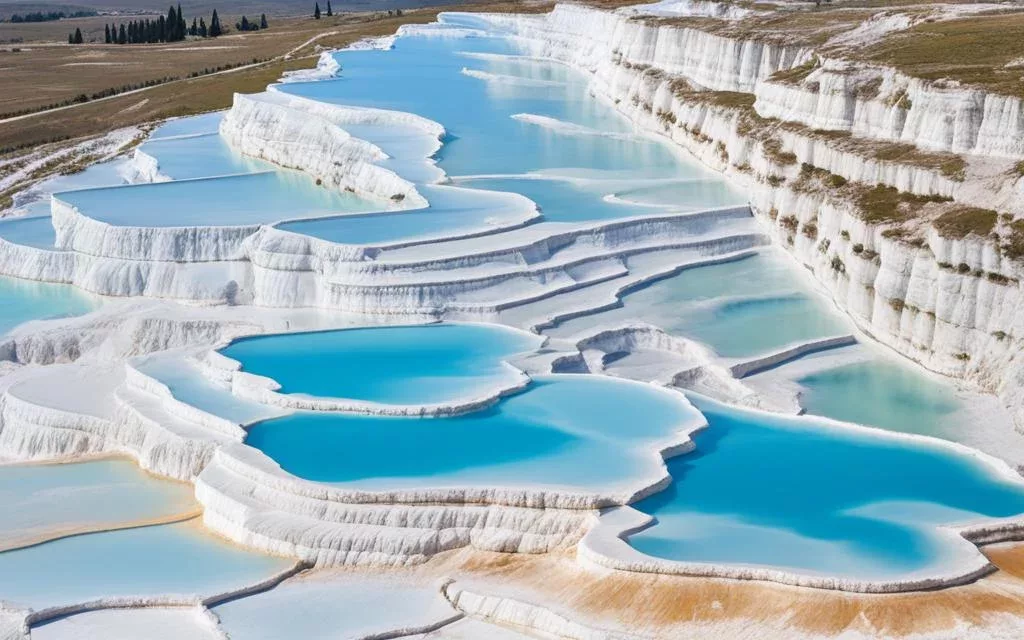
Years of hard work to protect Pamukkale have earned it worldwide praise. Today, people from all over come to see this amazing UNESCO site. They enjoy its beauty and historical importance.
| Conservation Efforts at Pamukkale | Impact |
|---|---|
| Demolition of hotels | Preserved the natural landscape and prevented further damage to the terraces |
| Restrictions on access | Reduced visitor impact and minimized the risk of damage to the fragile travertine formations |
| Controlled water release | Maintained the pristine white appearance of the pools, enhancing their visual appeal |
| Artificial pools | Provided alternative bathing areas, preserving the natural formations and reducing human impact |
Pamukkale stands as a reminder of how important it is to protect our natural wonders. By working together, we can keep this beautiful site safe and beautiful for the future.
Cleopatra’s Antique Pool.
Cleopatra’s Antique Pool is a hidden treasure among the beautiful Pamukkale thermal pools. Legends say Cleopatra bathed in this pool, fed by the same hot springs as the terraces around it. When you step into Cleopatra’s Antique Pool, it’s like traveling back in time.
The pool features ancient Roman columns and relics. It gives visitors a peek into the past’s luxury.
The waters here are clear, warm, and full of healing properties. Swimming in Cleopatra’s Pool combines history, nature, and relaxation. It’s a special experience. Locals and tourists enjoy the water’s healing effects surrounded by ancient Roman times.
Taking a dip here connects you with Cleopatra and ancient history. This tranquil place helps refresh your mind, body, and spirit.
Every stone in Cleopatra’s Antique Pool tells a tale. It invites you to be a part of this story. You can swim, float, or just soak in the atmosphere. You’ll leave feeling amazed and renewed.
“Swimming in Cleopatra’s Antique Pool was magical. The warm waters and ancient artifacts transported me to a time of emperors. It was incredible!” – Sarah Johnson, Travel Enthusiast
Important Tip: To honor Cleopatra’s Antique Pool’s history, please don’t touch or take any artifacts.
Don’t miss the chance to dive into the rich history and restorative waters of Cleopatra’s Antique Pool. It’s a unique experience.
Exploring the Ruins of Hierapolis.
The ruins of Hierapolis are a fascinating view into history. Visitors see ancient temples, theaters, and architectural wonders. These remains show the grandeur of the past. Walking through the ruins, the rich history and culture in every stone is undeniable.
Hierapolis has a big ancient burial ground, the largest in Turkey. It holds over 2,700 Roman graves. This necropolis reminds us of the people who once lived here. Each tomb has its own story, keeping memories alive.
For a deeper understanding of Hierapolis, a guided tour is recommended. A local guide can offer insights into the city’s past. They help visitors navigate the vast archaeological site.
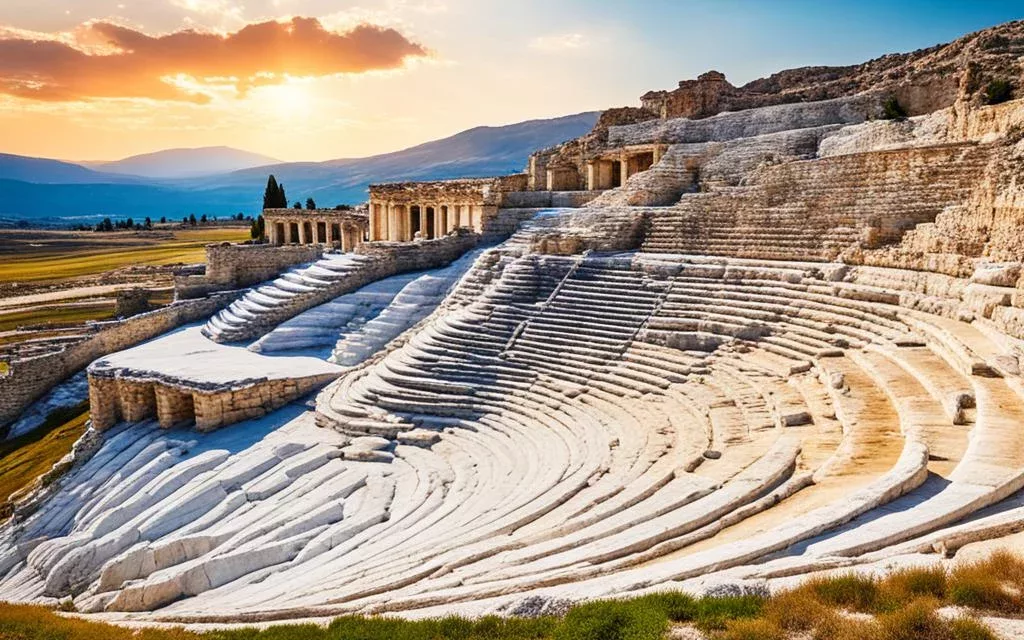
Hierapolis shows the skill of ancient people. The carved architecture and preserved daily life remnants open a window to the past.
Conservation Efforts
Keeping Hierapolis intact is crucial. Conservation efforts make sure future generations can learn from this historical treasure. The site is kept safe to stop more damage.
Conservation includes cleaning and maintaining the ruins. It also involves teaching people the value of preserving cultural heritage. Visitors can help protect this ancient city by being responsible tourists.
Highlights of the Ruins of Hierapolis
| Temple | Theater | Necropolis |
|---|---|---|
| Once dedicated to the ancient gods | Capacity of 15,000 spectators | Over 2,700 Roman graves |
| Impressive architectural features | Well-preserved stage and seating area | Historical artifacts and tombstones |
Exploring Hierapolis is like traveling through time. It’s a chance to see the legacy of ancient civilizations. It’s perfect for history buffs and anyone wanting to connect with our shared human history.
The Museum of Hierapolis.
The Museum of Hierapolis is a gem filled with ancient history. Located in Hierapolis, it brings to light the civilizations of yesteryears. Visitors get to see items from Hierapolis and nearby areas, understanding their rich history and culture.
Walking through the museum, you feel like you’ve stepped back in time. There are marble and stone artifacts from Greek, Roman, and Byzantine times. These pieces show the art, architecture, and daily life of ancient societies.
“Every piece in the museum tells a unique story, shedding light on the lives and customs of ancient peoples.”
The museum has three vaulted exhibition halls and open-air displays. These spaces offer a look into ancient religious, social, and technological advances. The artifacts reveal the ingenuity and creativity of ancient people.
The Conservation of Historical Treasures
The museum works hard to preserve these precious artifacts. Conservation efforts ensure these treasures last for more generations. The museum does restoration, research, and educational programs to keep the region’s culture alive.
When you visit, you not only see amazing things but also help preserve them. By following the museum’s rules, you support the conservation of ancient artifacts.
Opening Hours and Admission
The Museum of Hierapolis is open all year, giving visitors lots of time to explore. Staff are ready to help with any questions.
There’s a small entry fee that supports the museum’s work. The money goes towards preserving and showcasing the history of Hierapolis and its ancient people.
| Operating Hours | Admission Fee |
|---|---|
| Monday – Saturday: 9:00 AM – 7:00 PM | Adults: $10 |
| Sunday: 10:00 AM – 6:00 PM | Children (under 12): Free |
| Holidays: Closed | Students and Seniors: $5 |
Visit the Museum of Hierapolis for a journey into the past. Uncover the stories of ancient art, innovation, and culture that have left a mark on human history.
Other Travertine Formations Around the World.
Pamukkale is famous for its travertine formations. But it’s not the only spot with such beauty. Many places around the globe have similar natural attractions. They draw tourists from everywhere.
Here are some examples:
- Badab-e Surt in Iran: This marvel has terraces formed by mineral water. The orange and red colors make it a breathtaking sight.
- Mammoth Hot Springs in the United States: Found in Yellowstone National Park, it boasts stunning travertine terraces. Carbonate minerals from the hot springs create these beautiful structures.
- Pink and White Terraces in New Zealand: Known as the eighth wonder of the world before they were destroyed in 1886. They were made by geothermal activity.
- Hierve el Agua in Mexico: It looks like waterfalls frozen in time. Over thousands of years, mineral water flowing over cliffs has formed unique travertine shapes.
These locations let us see travertine beauty worldwide. Each place shows nature’s wonders through its unique features. Visitors get a peek into the amazing natural world.
| Location | Description |
|---|---|
| Badab-e Surt, Iran | A series of terraces with orange and red hues formed by mineral-rich water. |
| Mammoth Hot Springs, United States | Majestic travertine terraces created by hot springs in Yellowstone National Park. |
| Pink and White Terraces, New Zealand | Once considered the eighth wonder of the world, these terraces were destroyed in a volcanic eruption. |
| Hierve el Agua, Mexico | Natural cascading formations created by mineral-laden water flowing over cliffs. |
Essential Tips for Visiting Pamukkale.
Planning a trip to Pamukkale? Remember some key tips to enjoy your visit fully. Here are a few recommendations for a memorable trip:
- Footwear: At Pamukkale’s terraces, you must walk barefoot to protect the travertine formations. Carry your shoes in a comfy backpack while you explore.
- Environmental Consciousness: Pamukkale is protected as a UNESCO World Heritage site. It’s vital to tread lightly. Don’t walk on the terraces with shoes or touch the formations.
- Stay Hydrated and Wear Sunscreen: Pamukkale can be quite warm, particularly in summer. Always have a reusable water bottle and apply sunscreen to guard against the sun.
These tips can help you enjoy Pamukkale’s beauty responsibly and respectfully. You’ll ensure a fantastic experience.
Want more tips and detailed advice for visiting Pamukkale and Hierapolis? Then don’t miss this comprehensive guide. It offers thorough insights and advice for a rewarding journey.
How to Get to Pamukkale.
Pamukkale is in Denizli Province, Turkey. It’s famous for its beautiful travertine terraces and hot springs. Getting there is easy with several travel options.
By Air
The closest airport is Denizli Cardak Airport, with flights from Turkey’s big cities. You can take a taxi or shuttle to Pamukkale, about an hour away.
By Bus or Train
Travelers can also use a bus or train from Turkish cities. Denizli’s stations link to many places. A taxi or bus will then take you to Pamukkale quickly.
By Car
Driving from Istanbul takes about six hours. The journey offers lovely vistas of Turkey’s countryside. You can rent a car in major cities or airports.
Once you’re in Pamukkale, moving around is easy. Taxis and buses are there for local trips. They help visitors see all the main spots.
Conservation Efforts
Pamukkale is a UNESCO World Heritage Site. It’s vital to keep its ecosystem safe. Some areas are off-limits to protect the terraces and hot springs. Tours are carefully managed.
Guests must follow rules like not wearing shoes on the terraces. This helps keep Pamukkale beautiful for everyone in the future.
Conclusion.
Pamukkale’s thermal pools and travertine terraces are stunning and unique. They combine natural beauty, history, and healing waters. This makes them a top spot to see in Turkey. The terraces are created by mineral-rich water flows. They form a beautiful landscape that has attracted people for ages.
Conservation is key to keeping Pamukkale beautiful. Due to dangers like overdevelopment and neglect, protective steps are in place. Now, access to the pools is limited. This helps save the fragile structures. There are also man-made pools for tourists. This balances tourism and the preservation of natural sites.
Pamukkale has much to offer, from ancient ruins to relaxing hot springs. You can explore the old city of Hierapolis. Or, you can swim in Cleopatra’s Antique Pool, among Roman ruins. A trip here lets you enjoy its beauty, delve into history, and experience its healing waters.

